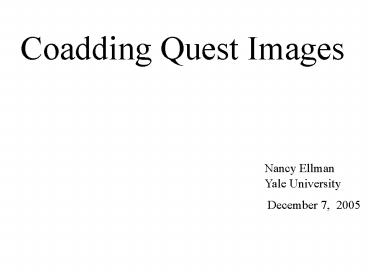Coadding Quest Images PowerPoint PPT Presentation
1 / 20
Title: Coadding Quest Images
1
Coadding Quest Images
Nancy Ellman
Yale University
December 7, 2005
2
Motivation
- To find positions of faint I-band objects for
quasar candidate selection. - To create a set of deep images to which we can
continue to add new data.
3
Limitations
- Concerned with unclustered objects only
- No psf matching during coaddition.
- No psf fitting during object detection.
- No scaling of images by relative depth.
- Use of variance image to track depth of each
individual pixel.
4
Atlas Image Definition
- An atlas image consists of a summed image and a
variance image. - Images are floating point, 4096 x 4096 pixels,
slightly less than 1 square degree. - Sky is divided into six sectors.
- A sector contains 18 columns of 181 frames each.
- Each sector uses 438 Gb of disk space.
5
Procedure
0. Preview scan.
- Flatfield raw image using pipeline routine.
- Create sky and variance images from a boxcar of
clipped flattened image. - Subtract sky.
- Find overlapping atlas images.
- Read existing atlas images, if any.
- Transform sky subtracted and variance images to
atlas reference frames. - Add to respective atlas images.
- Update image headers.
6
Complications
- Gain measurements.
- Bad columns (or flatfielding or dark )
- Bias weirdnes.
- Temperature fluctuations.
7
Scan Preview
- Estimate true gain from sky and noise.
- Identify bad columns from medians in sky
subtracted images. - Visual check of 1 frame per ccd per scan,
including flattened image, sky subtracted image
and variance mask.
8
(No Transcript)
9
Sky subtracted image
Variance image
10
Single frame coadded into four atlas images
11
Variance image for single coadded frame
12
Sum of frames from four scans
Associated variance image
13
Object Detection With the Pipeline
- The pipeline uses a single threshold per image or
detection, not a per-pixel threshold. - Psf likely varies too much over frame for
psf_detect to handle. - Code not conducive to modification for coadded
images.
14
Object Detection With Sextractor.
- Built in ability to use variance image.
- Portable code.
- Fast (2 seconds/frame).
- Many detection filters available.
15
Atlas Image With Pipeline Detections
Image is a sum of 4 frames. Psf detections from a
single frame in blue.
16
Atlas Image With Sextractor Detections
Image is sum of 4 frames. Sextractor detections
from sum in red.
17
Atlas Image With Both Sets of Detections.
18
Selecting Data to coadd.
- Must have good astrometry in wcs file.
- Using qa cuts program.
- Sky lt 3 times good sky
- FWHM lt 4
- F(k,sky) cut to be determined.
- 1 frame per ccd per scan must pass visual check.
19
Summary
- (Best) Time to add a single night (220 frames, 23
cols) 14 hrs/filter on one processor. - Disk space needed 3 Tb for all 6 sectors.
- Time for object detection 24 hrs/sector.
20
Update December 2005
- 20 of data coadded so far.
- Typical processing time 22 seconds per frame
(highly dependent on disk use). - Best processing time 10 seconds per frame.
- Time to process a good night (220 frames in 23
cols) 31 hrs (Johnson), 62 hrs (Gunn). With best
time 14/28 hrs. - Time to process remaining data assuming average
time/current disk/ 1 cpu lt 218 days!
(lt99/machine days w/best speed)

